Investigation of the Formation Mechanism and Environmental Risk of Tire—Pavement Wearing Waste (TPWW)
Abstract
:1. Introduction
2. Materials and Methods
2.1. Raw Materials
2.2. Wearing Test
2.3. Physical Analysis of TPWW
2.4. Chemical Analysis of TPWW
2.4.1. Heavy Metals Analysis
2.4.2. Organic Pollutants Analysis
3. Results and Discussion
3.1. Formulation of TPWW
3.2. Particle Size Distribution of TPWW
3.3. Morphology of TPWW
3.4. Environmental Analysis of TPWW
3.4.1. Organic Contaminant Content of TPWW
3.4.2. Heavy Metal Content of TPWW
4. Conclusions
Author Contributions
Funding
Institutional Review Board Statement
Informed Consent Statement
Data Availability Statement
Acknowledgments
Conflicts of Interest
References
- Yang, G.; Wang, H.; Pan, Y. Detection and evaluation methods of pavement wearing based on multi-line texture. China J. Highw. Transp. 2016, 29, 35–40. [Google Scholar]
- Wagner, S.; Hüffer, T.; Klöckner, P.; Wehrhahn, M.; Hofmann, T.; Reemtsma, T. Tire wear particles in the aquatic environment-a review on generation, analysis, occurrence, fate and effects. Water Res. 2018, 139, 83–100. [Google Scholar] [CrossRef] [PubMed]
- Day, J.P.; Hart, M.; Robinson, M.S. Lead in urban street dust. Nature 1975, 253, 343–345. [Google Scholar] [CrossRef]
- Dreelin, E.A.; Fowler, L.; Carroll, C.R. A test of porous pavement effectiveness on clay soils during natural storm events. Water Res. 2006, 40, 799–805. [Google Scholar] [CrossRef] [PubMed]
- Li, Y.; Helmreich, B. Simultaneous removal of organic and inorganic pollutants from synthetic road runoff using a combination of activated carbon and activated lignite. Sep. Purif. Technol. 2014, 122, 6–11. [Google Scholar] [CrossRef]
- Müller, A.; Österlund, H.; Marsalek, J.; Viklander, M. The pollution conveyed by urban runoff: A review of sources. Sci. Total Environ. 2020, 709, 136125. [Google Scholar] [CrossRef]
- Stokstad, E. Why were salmon dying? The answer washed off the road. Science 2020, 370, 1145. [Google Scholar] [CrossRef]
- Sharma, V.K.; Fortuna, F.; Mincarini, M.; Berillo, M.; Cornacchia, G. Disposal of waste tyres for energy recovery and safe environment. Appl. Energy 2000, 65, 381–394. [Google Scholar] [CrossRef]
- Xu, X.; Leng, Z.; Lan, J.; Wang, W.; Yu, J.; Bai, Y.; Sreeram, A.; Hu, J. Sustainable practice in pavement engineering through value-added collective recycling of waste plastic and waste tyre rubber. Engineering 2021, 7, 857–867. [Google Scholar]
- Hong, N.; Guan, Y.; Yang, B.; Zhong, J.; Zhu, P.; Ok, Y.S.; Hou, D.; Tsang, D.C.W.; Guan, Y.; Liu, A. Quantitative source tracking of heavy metals contained in urban road deposited sediments. J. Hazard. Mater. 2020, 393, 122362. [Google Scholar] [CrossRef]
- Tian, Z.; Zhao, H.; Peter, K.T.; Gonzalez, M.; Wetzel, J.; Wu, C.; Hu, X.; Prat, J.; Mudrock, E.; Hettinger, T.; et al. A ubiquitous tire rubber–derived chemical induces acute mortality in coho salmon. Science 2021, 371, 185–189. [Google Scholar] [CrossRef] [PubMed]
- Fan, Z.; Lin, J.; Chen, Z.; Liu, P.; Wang, D.; Oeser, M. Multiscale understanding of interfacial behavior between bitumen and aggregate: From the aggregate mineralogical genome aspect. Constr. Build. Mater. 2021, 271, 121607. [Google Scholar] [CrossRef]
- Viana, L.N.; Saint’Pierre, T.D. Direct determination of Cr and Ni in oil samples by isotope dilution and external standard calibration using inductively coupled plasma mass spectrometry. Microchem. J. 2019, 151, 104219. [Google Scholar] [CrossRef]
- de Souza, V.S.; Sena Gomes Teixeira, L.; Sthefane, J.; Lima, S.O.; Ferreira da Mata Cerqueira, U.M.; Cordeiro de Oliveira, O.M.; de Souza Queiroz, A.F.; Almeida Bezerra, M. Analytical strategies for spectrometric determination of vanadium in samples of interest in the petroleum industry. Appl. Spectrosc. Rev. 2020, 55, 128–157. [Google Scholar] [CrossRef]
- Sugiyama, I.; Williams-Jones, A.E. An approach to determining nickel, vanadium and other metal concentrations in crude oil. Anal. Chim. Acta 2018, 1002, 18–25. [Google Scholar] [CrossRef] [PubMed] [Green Version]
- Gab-Allah, M.A.; Goda, E.S.; Shehata, A.B.; Gamal, H. Critical review on the analytical methods for the determination of sulfur and trace elements in crude oil. Crit. Rev. Anal. Chem. 2020, 50, 161–178. [Google Scholar] [CrossRef]
- Niles, S.F.; Chacón-Patiño, M.L.; Putnam, S.P.; Rodgers, R.P.; Marshall, A.G. Characterization of an Asphalt Binder and Photoproducts by Fourier Transform Ion Cyclotron Resonance Mass Spectrometry Reveals Abundant Water-Soluble Hydrocarbons. Environ. Sci. Technol. 2020, 54, 8830–8836. [Google Scholar] [CrossRef]
- Brandt, H.C.A.; De Groot, P.C. Aqueous leaching of polycyclic aromatic hydrocarbons from bitumen and asphalt. Water Res. 2001, 35, 4200–4207. [Google Scholar] [CrossRef]
- Abd El-Wahab, H.; Abd El-Fattah, M.; Gabr, M.Y. Preparation and characterization of flame retardant solvent base and emulsion paints. Prog. Org. Coat. 2010, 69, 272–277. [Google Scholar] [CrossRef]
- Jin, X.Z.; Zheng, S.Z.; Li, R.Z.; Qiu, Y.; Cai, Y.P. Determination of soluble heavy metal Pb, Cd and Cr in water based architectural coatings for indoor decorating and refurbishing materials by ICP-AES. Guang Pu Xue Yu Guang Pu Fen Xi Guang Pu 2004, 24, 1127–1129. [Google Scholar]
- Pan, Y.; Ye, Y.; CAI, J.; Yuan, J.; Liang, S.; Chen, Z. Determination of 18 Polycyclic Aromatic Hydrocarbons Migrated from Asphalt Based Waterproof Coating by Solid Phase Microextraction/Gas Chromatography-Mass Spectrometry. J. Instrum. Anal. 2018, 37, 772–777. [Google Scholar]
- Li, T.; Lu, G.; Wang, D.; Oeser, M. Key Properties of High-performance Polyurethane Bounded Pervious Mixture. China J. Highw. Transp. 2019, 32, 158–169. [Google Scholar]
- Lu, G.; Törzs, T.; Liu, P.; Zhang, Z.; Wang, D.; Oeser, M.; Grabe, J. Dynamic response of fully permeable pavement: The development of pore pressures subjected to different modes of loading. ASCE’s J. Mater. Civ. Eng. 2020, 32, 04020160. [Google Scholar] [CrossRef]
- Lu, G.; Wang, Z.; Liu, P.; Wang, D.; Oeser, M. The Investigation on the Hydraulic Properties of Pervious Pavement Mixtures: Characterization of Darcy and Non-Darcy Flow Based on Pore Microstructures. ASCE’s J. Transp. Eng. Part B Pavements 2020, 146, 04020012. [Google Scholar] [CrossRef]
- Chen, X.H.; Steinauer, B.; Wang, D.W. Evolution of aggregate surface texture due to tyre-polishing. J. Cent. South Univ. Technol. 2011, 18, 259–265. [Google Scholar] [CrossRef]
- Wang, D.; Liu, P.; Wang, H.; Ueckermann, A.; Oeser, M. Modeling and testing of road surface aggregate wearing behaviour. Constr. Build. Mater. 2017, 131, 129–137. [Google Scholar] [CrossRef]
- Wang, D.; Liu, P.; Oeser, M.; Stanjek, H.; Kollmann, J. Multi-scale study of the polishing behaviour of quartz and feldspar on road surfacing aggregate. Int. J. Pavement Eng. 2019, 20, 79–88. [Google Scholar] [CrossRef]
- ASTM. ASTM D3319-2006 Standard Practice for the Accelerated Polishing of Aggregate Using the British Wheel; ASTM: West Conshohocken, PA, USA, 2017. [Google Scholar]
- Lu, G.; Wang, Y.; Li, H.; Wang, D.; Oeser, M. The environmental impact evaluation on the application of permeable pavement based on life cycle analysis. Int. J. Transp. Sci. Technol. 2019, 8, 351–357. [Google Scholar] [CrossRef]
- Lu, G.; Wang, H.; Zhang, Y.; Liu, P.; Wang, D.; Oeser, M.; Grabe, J. The hydro-mechanical interaction in novel polyurethane-bound pervious pavement by considering the saturation states in unbound granular base course. Int. J. Pavement Eng. 2021, 1–14. [Google Scholar] [CrossRef]
- Hong, B.; Lu, G.; Gao, J.; Wang, D. Evaluation of polyurethane dense graded concrete prepared using the vacuum assisted resin transfer molding technology. Constr. Build. Mater. 2021, 269, 121340. [Google Scholar] [CrossRef]
- Trujillo-González, J.M.; Torres-Mora, M.A.; Keesstra, S.; Brevik, E.C.; Jiménez-Ballesta, R. Heavy metal accumulation related to population density in road dust samples taken from urban sites under different land uses. Sci. Total Environ. 2016, 553, 636–642. [Google Scholar] [CrossRef]
- Yesilkanat, C.M.; Kobya, Y. Spatial characteristics of ecological and health risks of toxic heavy metal pollution from road dust in the Black Sea coast of Turkey. Geoderma Reg. 2021, 25, e00388. [Google Scholar] [CrossRef]
- Heidari, M.; Darijani, T.; Alipour, V. Heavy metal pollution of road dust in a city and its highly polluted suburb; quantitative source apportionment and source-specific ecological and health risk assessment. Chemosphere 2021, 273, 129656. [Google Scholar] [CrossRef]
- Wahab, M.I.A.; Abd Razak, W.M.A.; Sahani, M.; Khan, M.F. Characteristics and health effect of heavy metals on non-exhaust road dusts in Kuala Lumpur. Sci. Total Environ. 2020, 703, 135535. [Google Scholar] [CrossRef]
- Apeagyei, E.; Bank, M.S.; Spengler, J.D. Distribution of heavy metals in road dust along an urban-rural gradient in Massachusetts. Atmos. Environ. 2011, 45, 2310–2323. [Google Scholar] [CrossRef]
- Men, C.; Wang, Y.; Liu, R.; Wang, Q.; Miao, Y.; Jiao, L.; Shoaib, M.; Shen, Z. Temporal variations of levels and sources of health risk associated with heavy metals in road dust in Beijing from May 2016 to April 2018. Chemosphere 2021, 270, 129434. [Google Scholar] [CrossRef] [PubMed]
- Pan, H.; Lu, X.; Lei, K. A comprehensive analysis of heavy metals in urban road dust of Xi’an, China: Contamination, source apportionment and spatial distribution. Sci. Total Environ. 2017, 609, 1361–1369. [Google Scholar] [CrossRef]
- Zhao, L.; Hu, G.; Yan, Y.; Yu, R.; Cui, J.; Wang, X.; Yan, Y. Source apportionment of heavy metals in urban road dust in a continental city of eastern China: Using Pb and Sr isotopes combined with multivariate statistical analysis. Atmos. Environ. 2019, 201, 201–211. [Google Scholar] [CrossRef]
- Adila, H.; Mamattursun, E.; Gulbanu, H.; Jin, W.; Anwar, M.; Alimujiang, K. Pollution and health risks assessment of heavy metals of road dust in Korla City, Xinjiang. Geol. China 2020, 47, 1915–1925. [Google Scholar]
- Huang, B.; Zhou, Y.; Chang, W.; Li, Z.; Zeng, H. Differential Characteristics of Heavy Metal Pollution in Road Dust and Its Ecological Risk in Different Function Areas of Shenzhen City. Ecol. Environ. Sci. 2020, 47, 1915–1925. [Google Scholar]
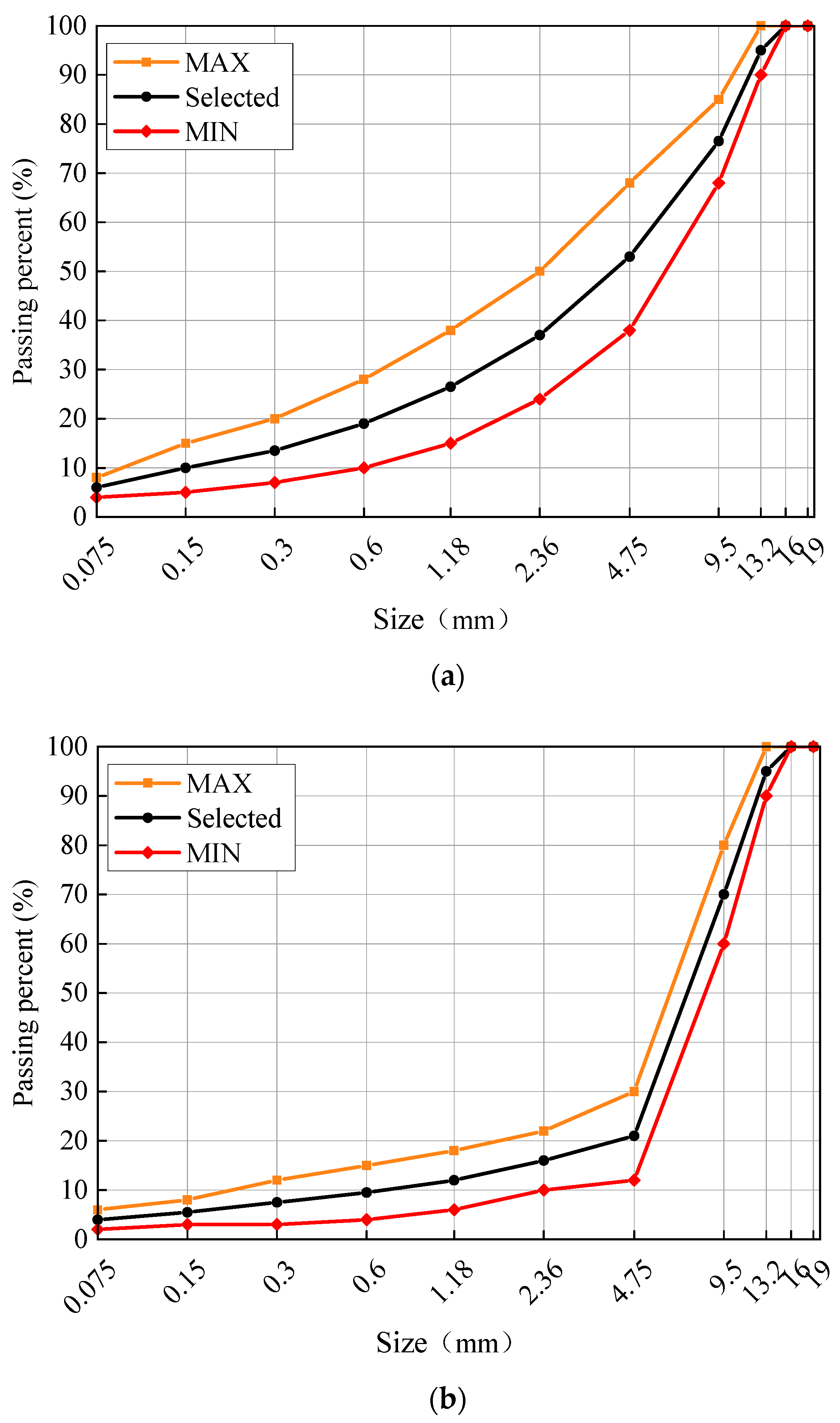

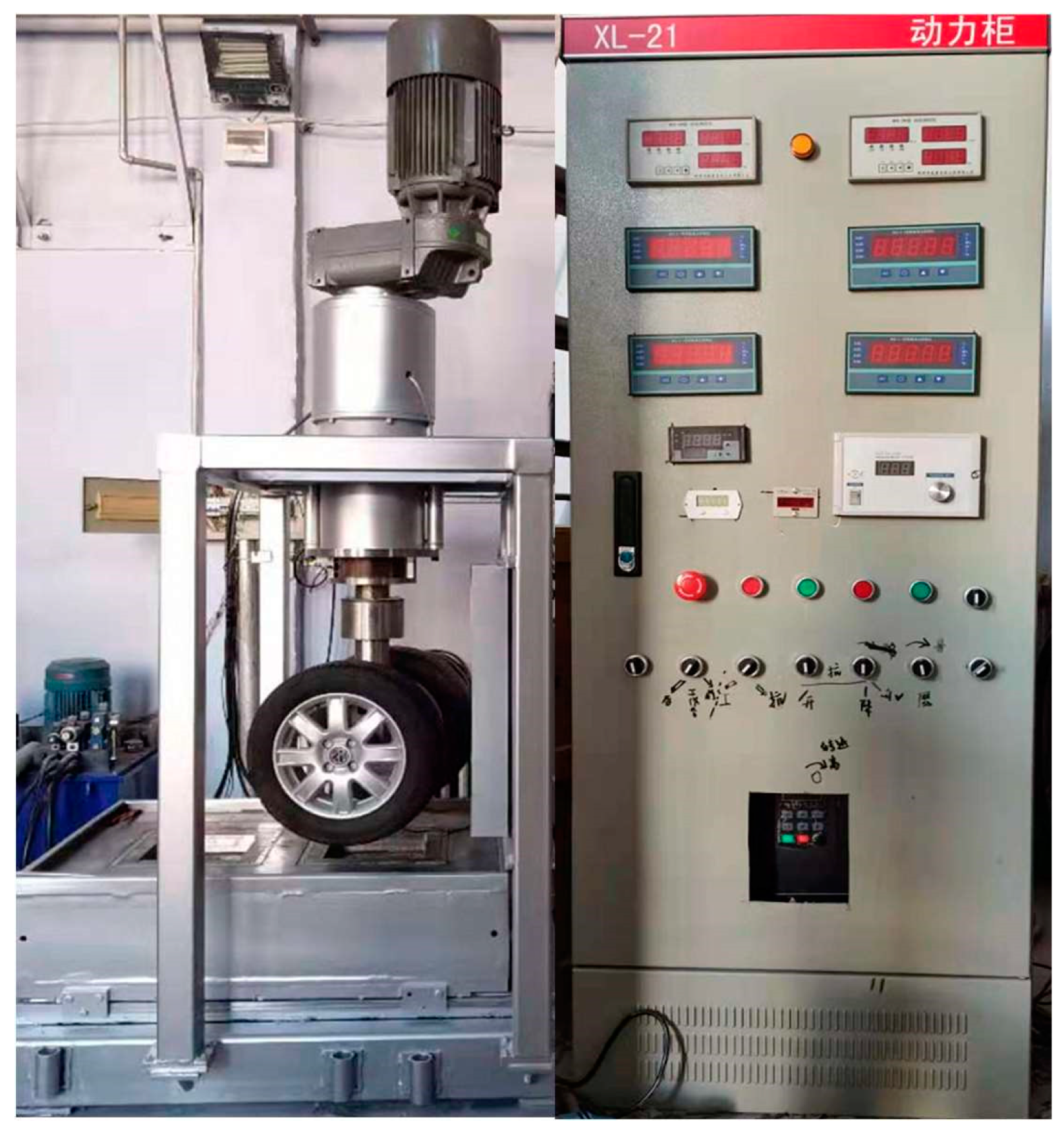
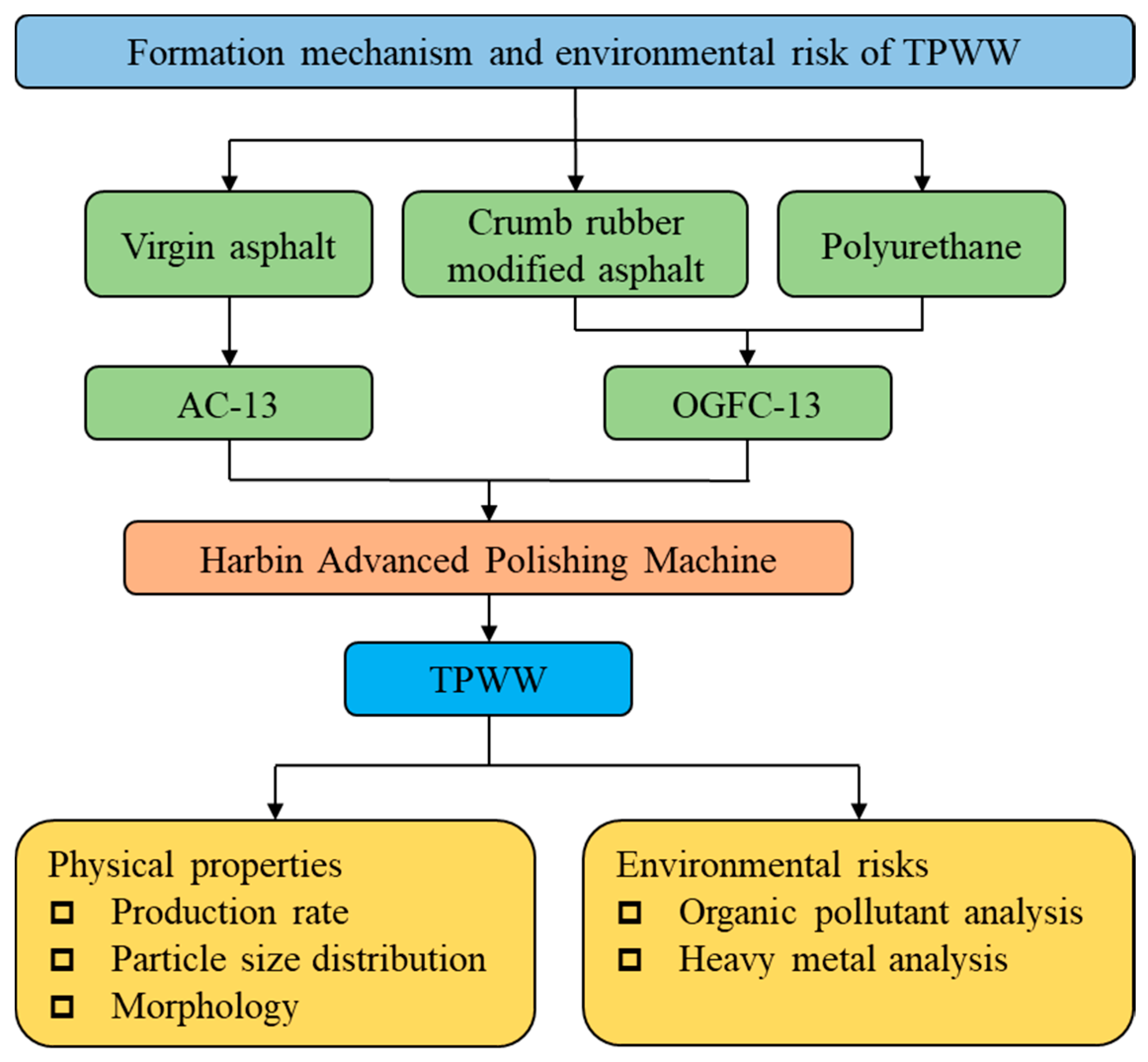
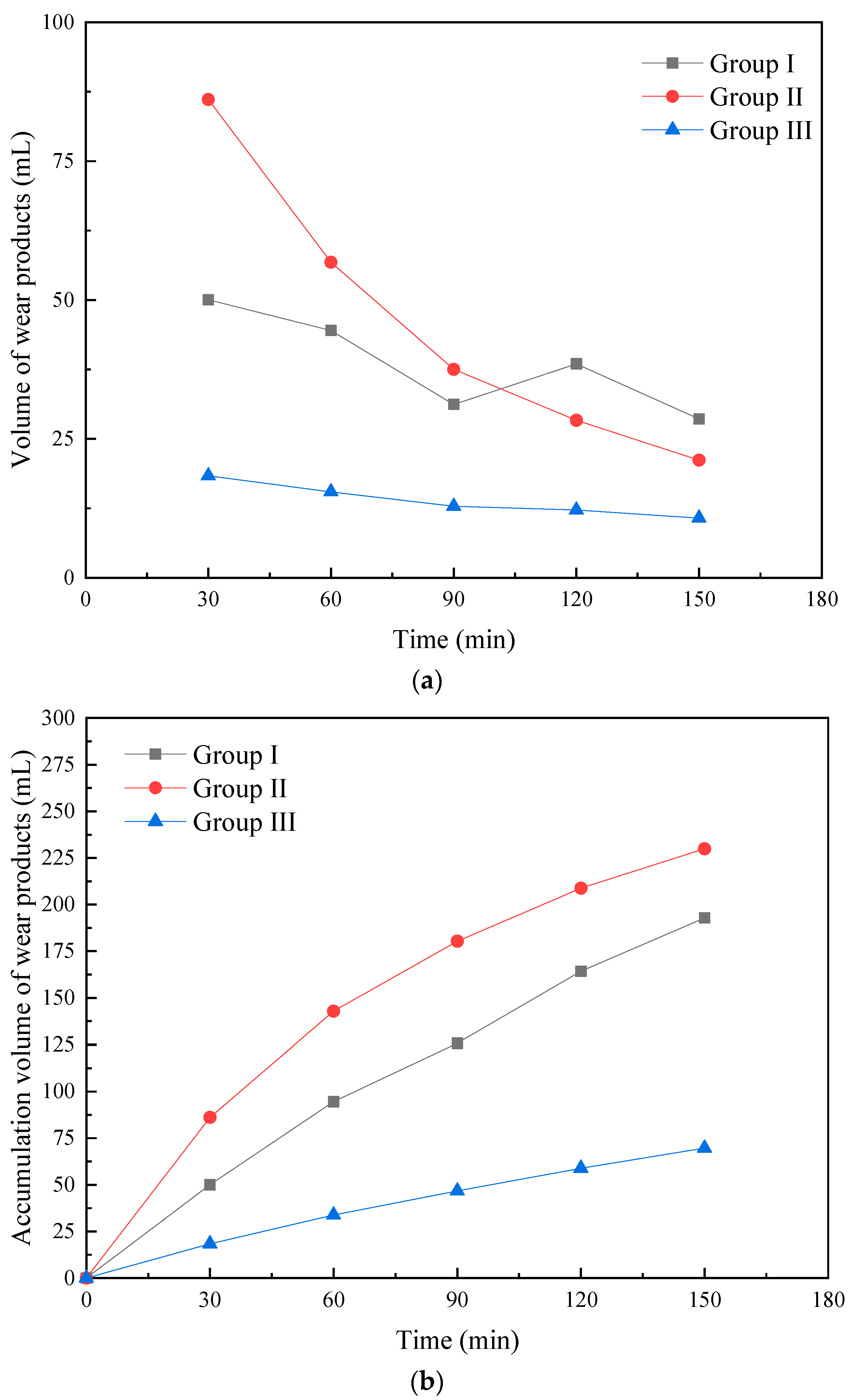
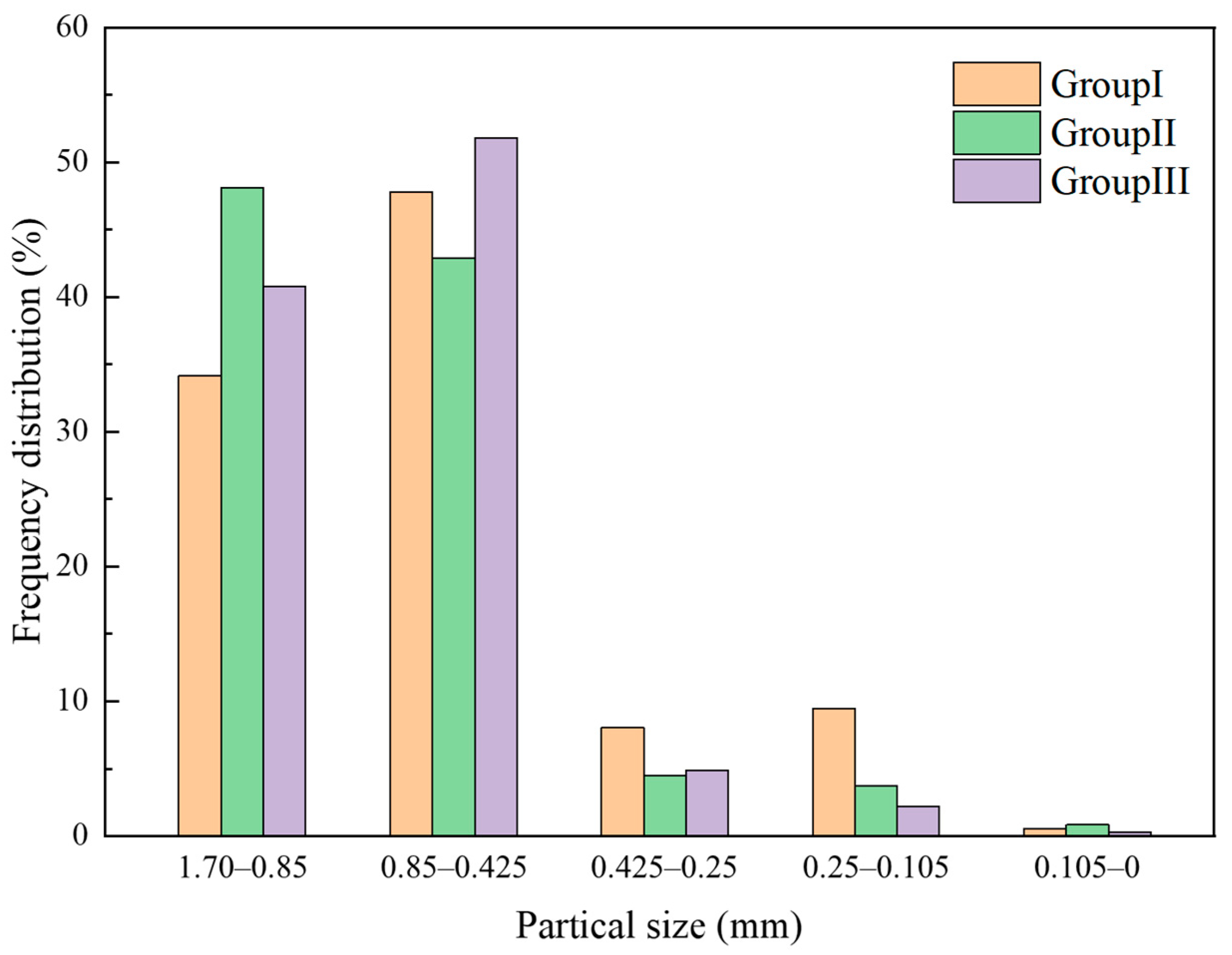


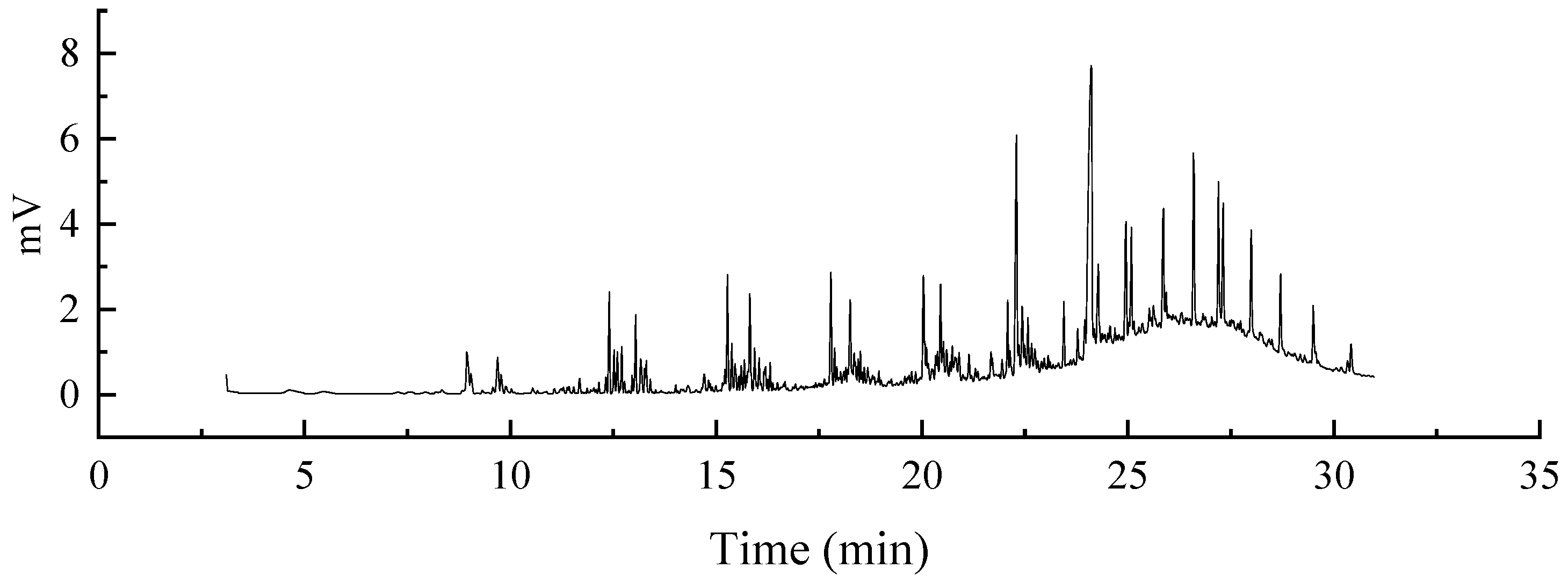
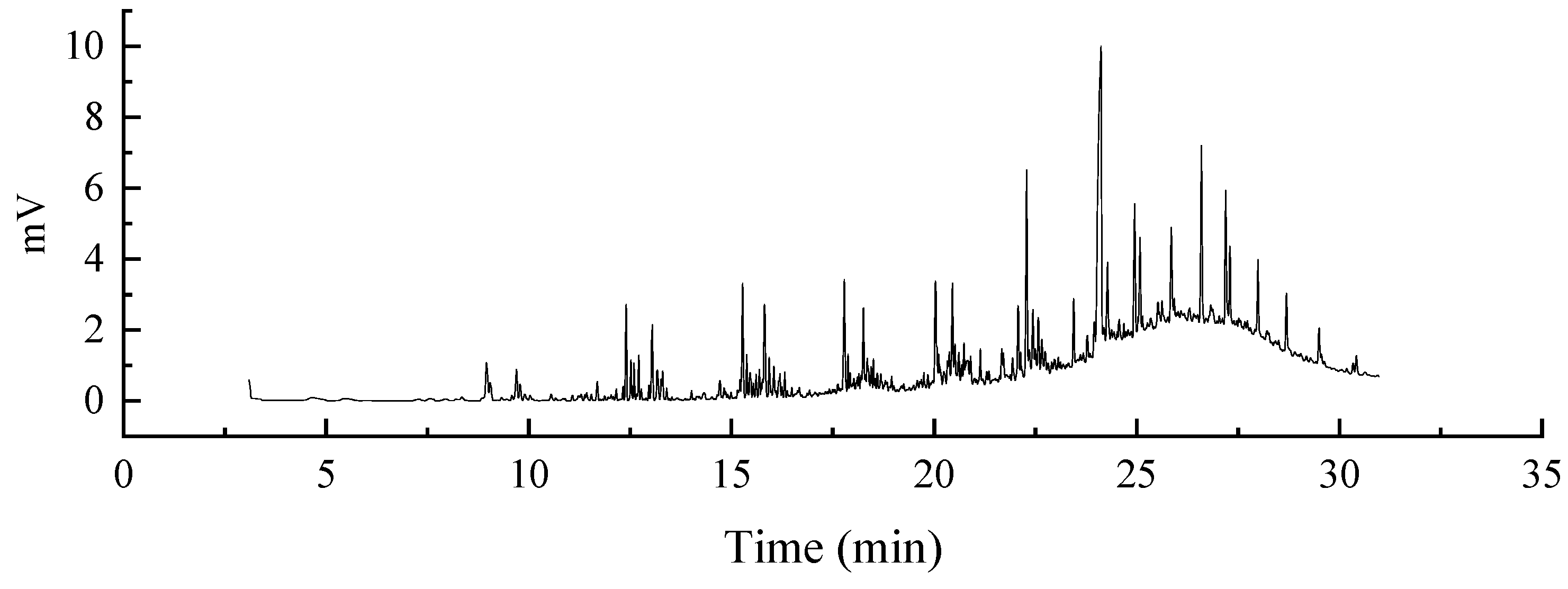
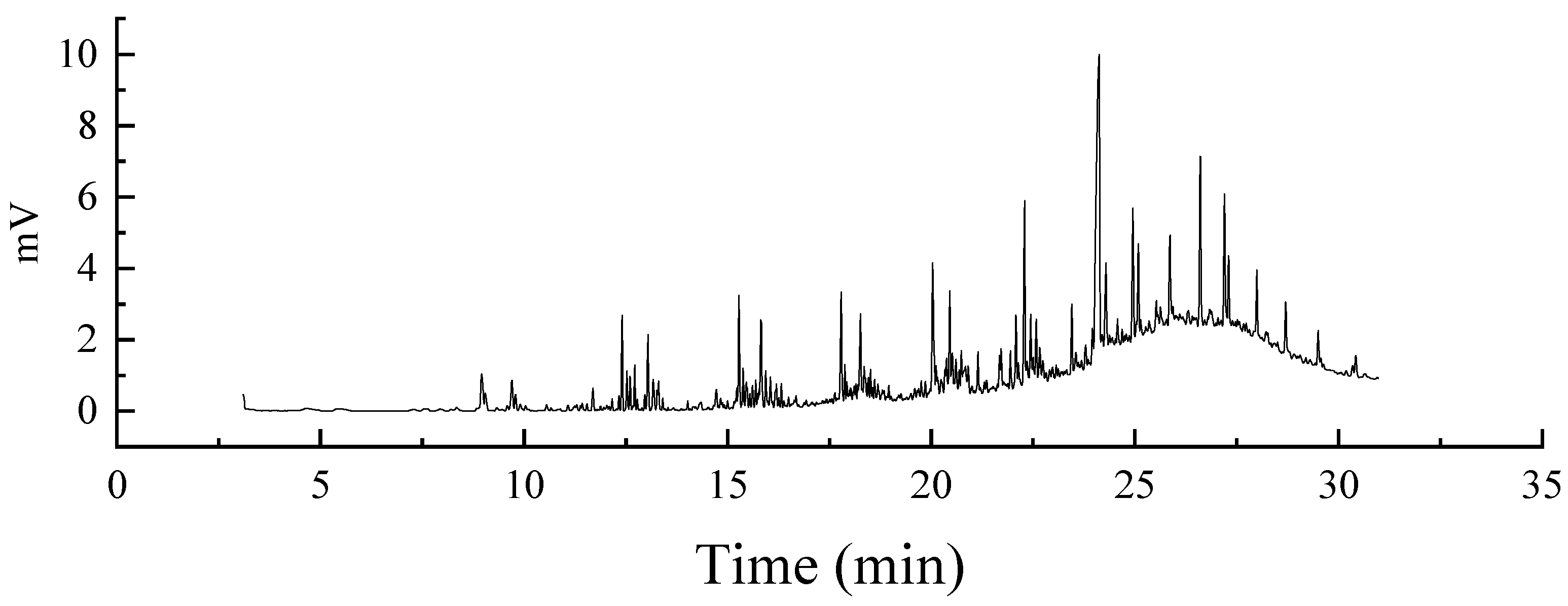
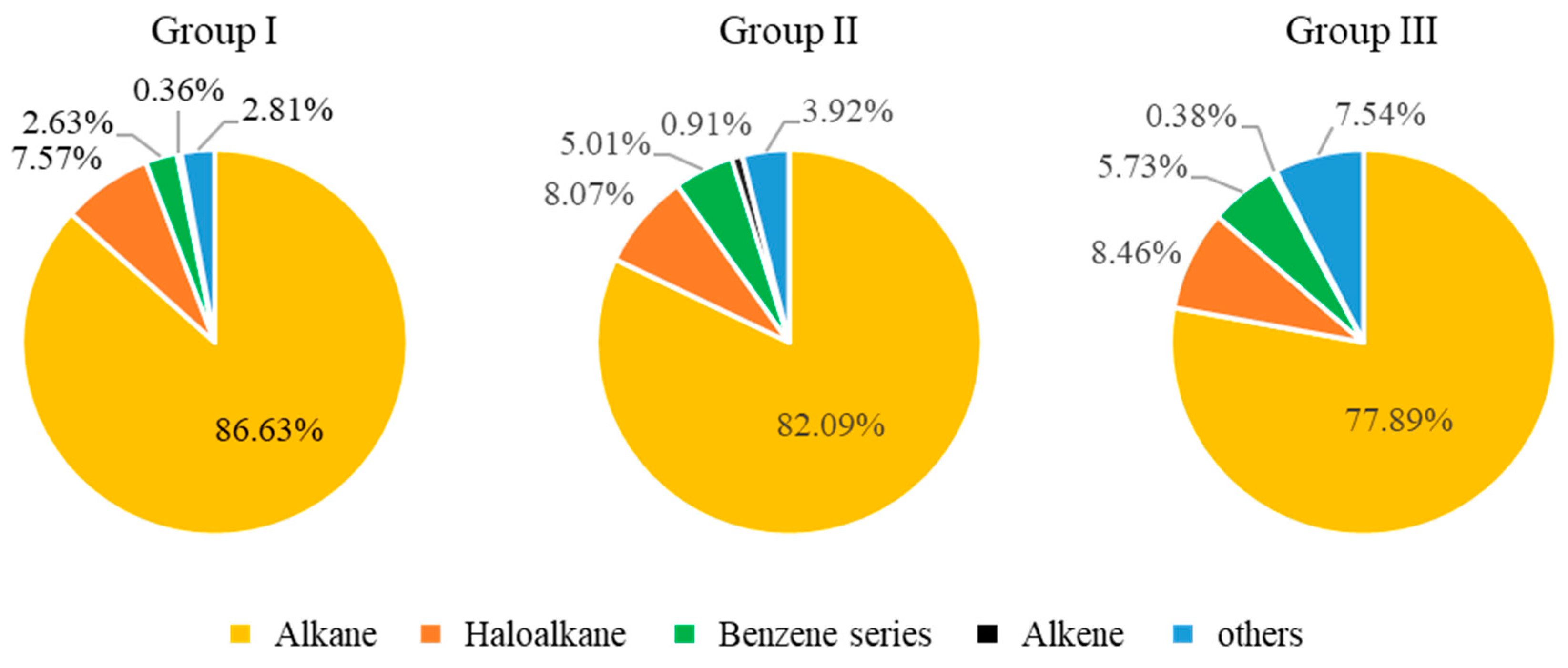
| Sample Number | Grading | Aggregate and Filler | Binder | Binder Content |
|---|---|---|---|---|
| Group I | AC-13 | Andesite and limestone | Virgin asphalt | 5.0% |
| Group II | OGFC-13 | Rubber modified asphalt | 4.6% | |
| Group III | OGFC-13 | Polyurethane | 4.6% |
| Parameter | Rotation Rate | Contact Pressure | Polishing Media | Sprinkling Rate | Temperature |
|---|---|---|---|---|---|
| Value | 100 rad/min | 1500 N | 50 g silica sand | 60 mL/min | 20 °C |
| Alkane | Haloalkane | Benzene Series | Alkene | Others | Sum | |
|---|---|---|---|---|---|---|
| Group I | 53 | 2 | 12 | 1 | 4 | 72 |
| Group II | 58 | 4 | 11 | 2 | 4 | 79 |
| Group III | 53 | 5 | 10 | 1 | 4 | 73 |
| Cd | Pb | Cr | Cu | Zn | |
|---|---|---|---|---|---|
| Virgin asphalt | 0.23 | 5.64 | 14.45 | 9.03 | 36.23 |
| Modified asphalt | 0.25 | 5.25 | 20.76 | 8.23 | 125.06 |
| Vehicle tire | 0.20 | 12.42 | 54.44 | 7.44 | 1458.08 |
| Group I | 0.69 | 13.93 | 545.27 | 25.87 | 1513.90 |
| Group II | 2.18 | 21.46 | 638.95 | 38.40 | 2192.22 |
| Group III | 0.54 | 15.32 | 218.16 | 14.43 | 1251.21 |
| City | Cd | Pb | Cr | Cu | Zn |
|---|---|---|---|---|---|
| Villavicencio [32] | – | 87.5 | 9.4 | 126.3 | 133.3 |
| Black Sea coast [33] | 0.4 | 59 | 59 | 132 | 457 |
| Bandar Abbas [34] | 0.42 | 60 | 74 | 149 | 293 |
| Kuala Lumpur [35] | 0.23 | 43.53 | 36.05 | 116.39 | 89.22 |
| Massachusetts [36] | – | 73 | 95 | 105 | 240 |
| Beijing [37] | 0.34 | 70.79 | 87.59 | 70.26 | 250.54 |
| Xi`an [38] | – | 124.5 | 145.0 | 54.7 | 268.6 |
| Nanchang [39] | 0.58 | 62 | – | 102 | 208 |
| Korla [40] | 0.06 | 37.93 | 56.44 | 34.33 | – |
| Shenzhen [41] | 0.67 | 136.46 | 75.86 | 108.97 | 286.57 |
Publisher’s Note: MDPI stays neutral with regard to jurisdictional claims in published maps and institutional affiliations. |
© 2021 by the authors. Licensee MDPI, Basel, Switzerland. This article is an open access article distributed under the terms and conditions of the Creative Commons Attribution (CC BY) license (https://creativecommons.org/licenses/by/4.0/).
Share and Cite
Wang, K.; Chu, X.; Lin, J.; Yang, Q.; Fan, Z.; Wang, D.; Oeser, M. Investigation of the Formation Mechanism and Environmental Risk of Tire—Pavement Wearing Waste (TPWW). Sustainability 2021, 13, 8172. https://doi.org/10.3390/su13158172
Wang K, Chu X, Lin J, Yang Q, Fan Z, Wang D, Oeser M. Investigation of the Formation Mechanism and Environmental Risk of Tire—Pavement Wearing Waste (TPWW). Sustainability. 2021; 13(15):8172. https://doi.org/10.3390/su13158172
Chicago/Turabian StyleWang, Kechen, Xiangyu Chu, Jiao Lin, Qilin Yang, Zepeng Fan, Dawei Wang, and Markus Oeser. 2021. "Investigation of the Formation Mechanism and Environmental Risk of Tire—Pavement Wearing Waste (TPWW)" Sustainability 13, no. 15: 8172. https://doi.org/10.3390/su13158172
APA StyleWang, K., Chu, X., Lin, J., Yang, Q., Fan, Z., Wang, D., & Oeser, M. (2021). Investigation of the Formation Mechanism and Environmental Risk of Tire—Pavement Wearing Waste (TPWW). Sustainability, 13(15), 8172. https://doi.org/10.3390/su13158172








